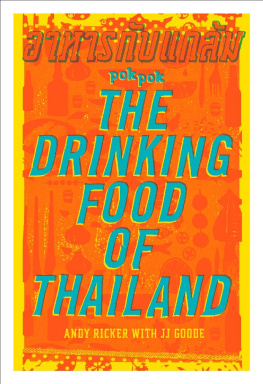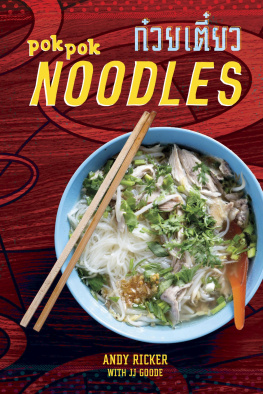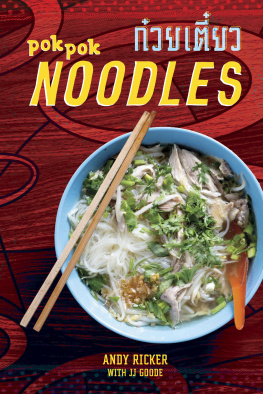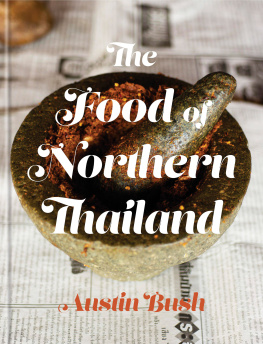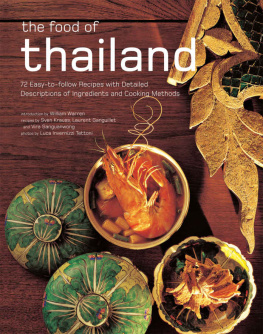Andy Ricker - POK POK The Drinking Food of Thailand
Here you can read online Andy Ricker - POK POK The Drinking Food of Thailand full text of the book (entire story) in english for free. Download pdf and epub, get meaning, cover and reviews about this ebook. year: 2017, publisher: Ten Speed Press, genre: Home and family. Description of the work, (preface) as well as reviews are available. Best literature library LitArk.com created for fans of good reading and offers a wide selection of genres:
Romance novel
Science fiction
Adventure
Detective
Science
History
Home and family
Prose
Art
Politics
Computer
Non-fiction
Religion
Business
Children
Humor
Choose a favorite category and find really read worthwhile books. Enjoy immersion in the world of imagination, feel the emotions of the characters or learn something new for yourself, make an fascinating discovery.
- Book:POK POK The Drinking Food of Thailand
- Author:
- Publisher:Ten Speed Press
- Genre:
- Year:2017
- Rating:3 / 5
- Favourites:Add to favourites
- Your mark:
- 60
- 1
- 2
- 3
- 4
- 5
POK POK The Drinking Food of Thailand: summary, description and annotation
We offer to read an annotation, description, summary or preface (depends on what the author of the book "POK POK The Drinking Food of Thailand" wrote himself). If you haven't found the necessary information about the book — write in the comments, we will try to find it.
Andy Ricker: author's other books
Who wrote POK POK The Drinking Food of Thailand? Find out the surname, the name of the author of the book and a list of all author's works by series.
POK POK The Drinking Food of Thailand — read online for free the complete book (whole text) full work
Below is the text of the book, divided by pages. System saving the place of the last page read, allows you to conveniently read the book "POK POK The Drinking Food of Thailand" online for free, without having to search again every time where you left off. Put a bookmark, and you can go to the page where you finished reading at any time.
Font size:
Interval:
Bookmark:
INGREDIENTS
Once you collect half a dozen bottled sauces and a handful of fresh ingredientsmany of which, like Thai chiles, galangal, and makrut lime leaves, to name a few, keep well in the freezerthe food in this book becomes a lot easier to cook. Here is a rundown of some of the most commonly used ingredients that require explanation.
Unless otherwise noted, youll find these items at Asian markets that specialize in Southeast Asian foods or have a robust Southeast Asian section. Plus, nowadays, even many supermarkets stock Thai chiles, lemongrass, and turmeric root. A few ingredients, however, require a bit of searching. To locate the Thai herb phak chii farang, you might find yourself at a Vietnamese market (where it goes by ng gai) or a Latin one (where it is called recao or culantro). Mexican markets stock dried puya chiles, which Ive found to be the best stand-in for the hard-to-find Thai chile phrik kaeng. Your local farmers market might sell Thai basil, cilantro with the roots on, and goat horn chiles. If youre stymied, theres always the megastore known as the Internet.
Banana leaf (bai yok)
Primarily used to wrap fish and meat before grilling, banana leaves impart a subtle tannic flavor and aroma. Theyre occasionally available fresh but are more typically sold frozen in Asian and Latin markets (where they go by hoja de platano).
Blood (leuat)
Used to enrich the flavor of dishes like boat noodles and Northern Thai laap, raw blood can be found in the freezer case at Korean and Chinese markets or at butcher shops that work closely with small local farms and allow special orders.
Chinese celery (kheun chai)
A common ingredient in stir-fries and soups, this variety is leafier and has much thinner stems than the celery ubiquitous in supermarkets in the States. Look for it in the produce section of Asian markets.
Chinese keys (krachai)
Youll likely only find this rhizome frozen in the United States, which works well for the recipes in this book. Look for it, whole or shredded, in Chinese and Southeast Asian markets, where it might also be labeled grachai or krachai. Its sometimes referred to as lesser galangal, Chinese keys, or simply rhizome. Avoid canned or jarred krachai.
Cilantro root (rak phak chii)
In the United States, cilantro (or coriander) is typically sold without its root attached. When you see roots-on bunches at farmers markets and Southeast Asian grocery stores, buy them (or ask if you can place a special order). Thinly slice the roots you dont use after several days and freeze them. The root adds the punchy flavor without the men khiaw (the strong green quality that some call soapiness) of the leaves.
Coriander seeds (met phak chii)
Those eager to go the extra mile will use the coriander seeds sold at Asian grocery stores rather than the ones available at your local supermarket. The Asian seeds have a nutty, spicy quality, while the Western ones call to mind hot dogs a bit too vividly for my taste.
Dried long peppers (dippli)
Most good spice shops carry this variety of dried pepper, which is occasionally used in Northern Thai cooking and has a complex, less harsh flavor than common black peppercorns. Called pippali in Indian and Malay its most readily available at specialty spice shops and online.
Fish sauce (naam plaa)
Look for bottles of this intensely salty seasoning and condiment made from salted, fermented fish on shelves in Asian markets. For Thai fish sauce, the Squid and Tiparos brands are solid (avoid the common Thai Kitchen brand) and Megachef is best. Avoid Vietnamese brands for the recipes in this book. They are mild and sweet in comparison to Thai brands, a different flavor profile for a different cuisine.
Galangal (khaa)
Pounded into many seasoning pastes, this knobby rhizome looks like pale-skinned ginger but tastes citrusy, almost soapy, and much less sharp than its kin. Find it fresh in Thai and some Chinese grocery stores in the refrigerated section or near the produce and in the freezer section of many Asian markets.
Gouramy fish, pickled (plaa raa)
This fermented fish (also called pa laa, ba laa, or other similar phonetic transliteration; mm c sc in Vietnamese; and salted gourami), sold in jars, is a common ingredient in the cooking of North and Northeastern Thailand. Look for Pantainorasingh brand or other brands that sell whole fish or fillets (not creamy or cream style) in the same aisle where you spot jarred sauces and condiments.
Green Anaheim, Hungarian wax, and goat horn chiles
Look for these fresh chileswhich mimic the relatively mild heat, flavor, and aroma of certain Thai chiles used in stir-fries and chile dipsat supermarkets and at farmers markets in the summer. The long (about 6 inches / 15 cm) unnamed green chiles sold in Asian markets in the States will also do the trick.
Holy basil (bai kaphrao)
Holy basil, also known as hot basil, which has a peppery flavor and intense, distinctive aroma, is used most famously in a Thai stir-fry of ground pork or chicken. Your best bet for finding it is a Thai-focused market (ask for by ga-POW). Beware, however, as Ive seen the label holy basil attached to purple-stemmed Thai or sweet basil.
Lemongrass (takhrai)
Lemongrass has become fairly common in big-city markets, Asian and not. Many recipes call for the soft, tender heart of the stalk. The size and freshness will affect the yield of thinly sliced tender parts, though you can figure on about 7 g / 1 tablespoon for every large stalk. To access it, remove 1 inch / 2.5 cm from the bottom and about 9 inches / 23 cm from the top of the stalk. Next, peel off the fibrous layers. After 5 layers, you should have reached the tender portion. Start slicing at the bottom, discarding any parts that give a sharp knife pause.
Makhwen
The dried seeds of the Northern Thai prickly ash tree (Zanthoxylum limonella Alston), used as a spice in some Northern Thai dishes, are hard but not impossible to find in the West. Ask around at Thai markets and poke around online. Look for creative descriptions like Thai Sichuan peppercorns.
Makrut lime leaves (bai makrut)
The fragrant leaves of the makrut lime tree are available fresh (typically in the refrigerated section) or frozen in Thai and some Asian or Indian grocery stores. Do not use dried leaves. If you dont use fresh leaves within a couple of days of purchasing them, freeze them for up to 3 months.
MSG (phong chu roht)
A few recipes in this book call for this maligned ingredient, so grab a bag of monosodium glutamate. The white stuff is often sold under the Japanese Ajinomoto brand, but sometimes, especially in Western stores, it is labeled Accent.
Oyster sauce (naam man hoi)
A common bottled seasoning in Thai cooking, oyster sauce should have a salty, briny flavor along with a mellow sweetness, not just an intense saltiness. To achieve the right flavor for the recipes in this book, buy a Thai brand, such as Maekrua, which youll find at Southeast Asian and most Chinese markets.
Palm sugar (naam taan)
Soft palm sugar (naam taan piip) is sold in small plastic containers at Thai markets. A gentle squeeze will tell you if its hardened from improper storage. If you must, you can buy palm sugar in hard disk form (naam taan beuk) and approximate the soft stuff by microwaving it with a splash of water just until it softens. Either way, look for brands that sell 100 percent palm sugar from Thailand, such as Golden Chef or Cock.
Puya chiles, dried
Next pageFont size:
Interval:
Bookmark:
Similar books «POK POK The Drinking Food of Thailand»
Look at similar books to POK POK The Drinking Food of Thailand. We have selected literature similar in name and meaning in the hope of providing readers with more options to find new, interesting, not yet read works.
Discussion, reviews of the book POK POK The Drinking Food of Thailand and just readers' own opinions. Leave your comments, write what you think about the work, its meaning or the main characters. Specify what exactly you liked and what you didn't like, and why you think so.

